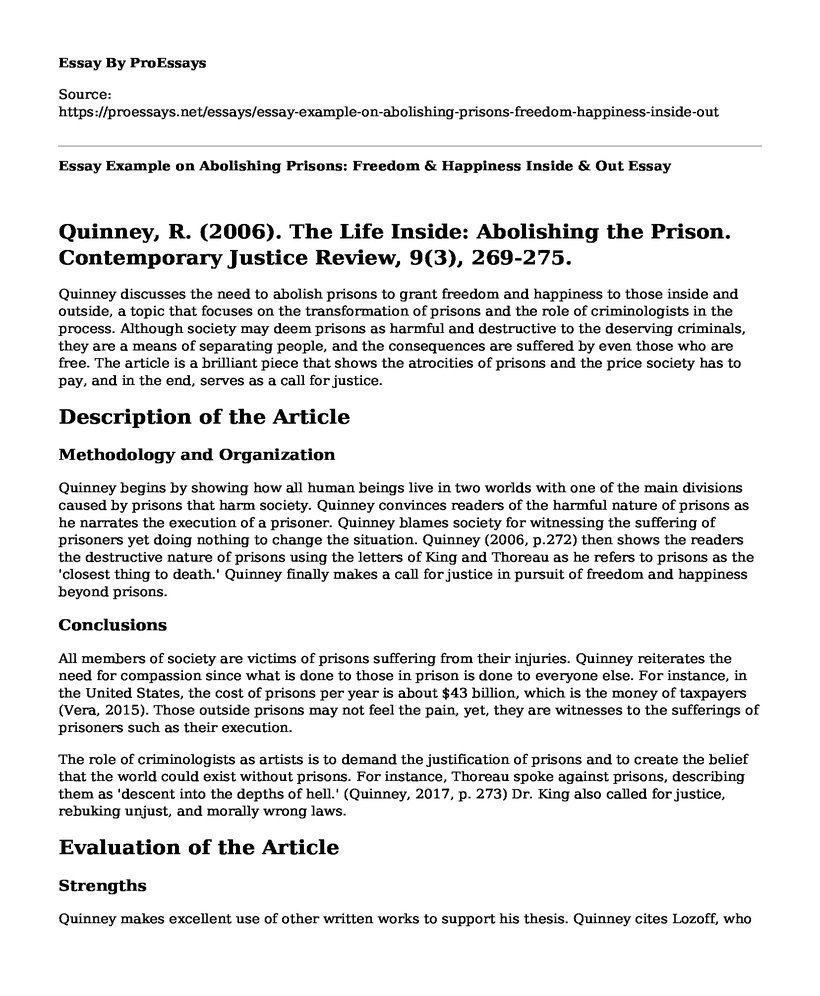Quinney, R. (2006). The Life Inside: Abolishing the Prison. Contemporary Justice Review, 9(3), 269-275.
Quinney discusses the need to abolish prisons to grant freedom and happiness to those inside and outside, a topic that focuses on the transformation of prisons and the role of criminologists in the process. Although society may deem prisons as harmful and destructive to the deserving criminals, they are a means of separating people, and the consequences are suffered by even those who are free. The article is a brilliant piece that shows the atrocities of prisons and the price society has to pay, and in the end, serves as a call for justice.
Description of the Article
Methodology and Organization
Quinney begins by showing how all human beings live in two worlds with one of the main divisions caused by prisons that harm society. Quinney convinces readers of the harmful nature of prisons as he narrates the execution of a prisoner. Quinney blames society for witnessing the suffering of prisoners yet doing nothing to change the situation. Quinney (2006, p.272) then shows the readers the destructive nature of prisons using the letters of King and Thoreau as he refers to prisons as the 'closest thing to death.' Quinney finally makes a call for justice in pursuit of freedom and happiness beyond prisons.
Conclusions
All members of society are victims of prisons suffering from their injuries. Quinney reiterates the need for compassion since what is done to those in prison is done to everyone else. For instance, in the United States, the cost of prisons per year is about $43 billion, which is the money of taxpayers (Vera, 2015). Those outside prisons may not feel the pain, yet, they are witnesses to the sufferings of prisoners such as their execution.
The role of criminologists as artists is to demand the justification of prisons and to create the belief that the world could exist without prisons. For instance, Thoreau spoke against prisons, describing them as 'descent into the depths of hell.' (Quinney, 2017, p. 273) Dr. King also called for justice, rebuking unjust, and morally wrong laws.
Evaluation of the Article
Strengths
Quinney makes excellent use of other written works to support his thesis. Quinney cites Lozoff, who emphasizes that all human beings are in pursuit of happiness. Also, to show the pain of prisoners, Quinney incorporates the works of Sennett and Cobb, who describe the painful hanging of a peasant.
Quinney also uses ethos, pathos, and logos to persuade and convince readers of his thesis. Quinney uses pathos by describing human beings as voyeurs in their role as witnesses to suffering. Quinney also uses logos by citing authorities such as Dr. King and Thoreau to show the credibility of his writing.
Weaknesses
Quinney claims that the effects of prisons are felt by everyone. However, he fails to provide compelling evidence of how society suffers. Instead of supporting the idea, Quinney repeats the same point in three paragraphs in the first three paragraphs on page 270.
Quinney also dwells on the past citing works written far back in time and provides no current statistics or information to support his thesis. For instance, he focuses on the letter from Birmingham written in 1963 by Martin Luther King and the letter by Thoreau. Quinney fails to provide any current statistics in prisons, such as the world prison population, which is about nine million that would have helped support his thesis (BBC, 2020).
Conclusion
Despite a few weaknesses in his writing, Quinney adequately explains how prisons are destructive to all, thus the need to pursue freedom and happiness by abolishing them. The article is well written, incorporating various credible sources that serve to educate readers and also call for justice in society.
References
BBC (2020). World Prison Populations. Retrieved from http://news.bbc.co.uk/2/shared/spl/hi/uk/06/prisons/html/nn2page1.stm
King, M.L. (1963). Letter from Birmingham Jail. The Atlantic. Retrieved from https://www.theatlantic.com/magazine/archive/2018/02/letter-from-birmingham-jail/552461/
Quinney, R. (2006). The Life Inside: Abolishing the Prison. Contemporary Justice Review, 9(3), 269-275.
Vera (2015). Prison Spending in 2015. Retrieved from https://www.vera.org/publications/price-of-prisons-2015-state-spending-trends/price-of-prisons-2015-state-spending-trends/price-of-prisons-2015-state-spending-trends-prison-spending
Cite this page
Essay Example on Abolishing Prisons: Freedom & Happiness Inside & Out. (2023, Mar 26). Retrieved from https://proessays.net/essays/essay-example-on-abolishing-prisons-freedom-happiness-inside-out
If you are the original author of this essay and no longer wish to have it published on the ProEssays website, please click below to request its removal:
- Persuasive Essay: Stealing Music Is a Crime That Should be Punished Severely
- Legalizing Marijuana: Economic, Health Benefits & More - Essay Sample
- Essay Example on Psychopaths: Impact on Criminal Justice Systems
- Essay on Estonia Protects People With Disabilities: Challenges and Opportunities
- Truth & Reconciliation Commissions: Examining Past Human Rights Abuses & Historical Injustices - Essay Sample
- Paper Example on VVBC Members Charged: Virtual PD's Organized Investigation
- Sperm Donor Anonymity in Australia: Legal Challenges and Proposed Frameworks - Free Paper







